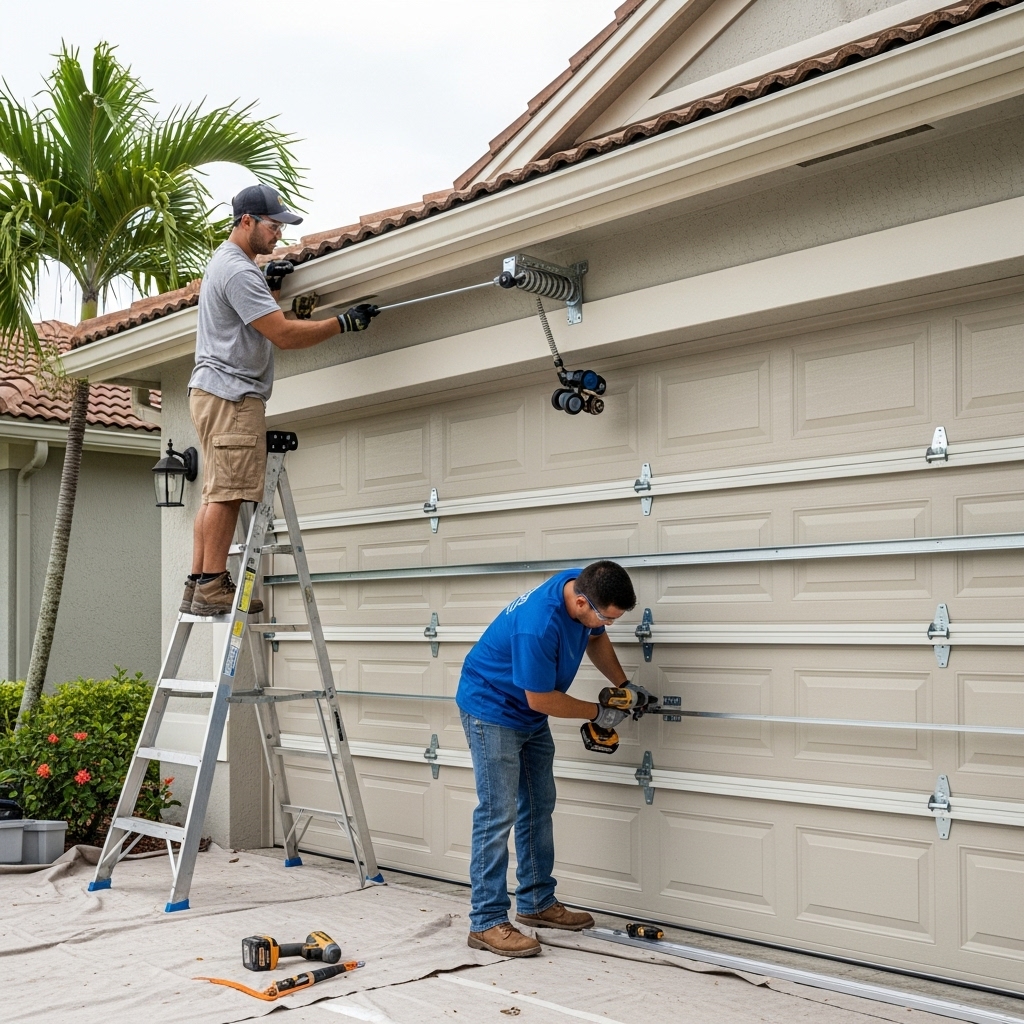A successful garage door installation in Florida is less about rushing through the day of work and more about careful preparation that begins weeks earlier. Between wind design requirements, product approvals, and inspections, each stage plays a role in how well your new door resists storms, operates daily, and passes code review. This step-by-step guide lays out what to expect from consultation to final inspection so you can plan your time and make confident decisions. For homeowners who prefer a turnkey experience, partnering with specialists in garage door installation helps align product selection, permitting, and workmanship with Florida’s building codes from day one.
Step 1: Initial Consultation and Needs Assessment
Start with a walk-through of your garage and driveway. Discuss how you use the space—daily parking, workshop area, or storage—and whether noise control, insulation, or impact resistance is most important. Review any HOA style requirements and assess whether a single or double door best fits your routine and vehicles. This is also the time to note headroom constraints, backroom depth, and side room clearance for tracks and spring assemblies. A clear picture of your needs and constraints ensures your product options match the space and the local code.
Step 2: Measurements and Site Conditions
Accurate measurements are the backbone of a smooth installation. The installer should record opening width and height in multiple locations, headroom to the lowest obstruction, side room on both sides, and backroom for track and opener clearance. The slab should be checked for levelness and the framing examined for plumb, square, and structural soundness. If reinforcements are needed—such as beefed-up jambs or additional blocking—planning them now avoids surprises later.
Step 3: Product Selection and Approvals
Choose door construction and features that satisfy code and your lifestyle. In coastal or wind-borne debris regions, that often means wind-rated or impact-rated models with reinforced sections and upgraded hardware. Materials should be corrosion-resistant and finishes UV-stable. The opener should be sized to the door weight, with quiet operation, battery backup for outages, and smart connectivity if desired. The installer will assemble the product approval documentation and any engineering required to match your municipality’s wind design criteria.
Step 4: Permitting
Most Florida jurisdictions require a permit for garage door replacement or new installation. The permit application typically includes the door’s product approval, wind load data, and installation instructions. Submitting a complete package reduces back-and-forth and accelerates approvals. Once issued, the permit should be posted on-site, and the project moves forward with ordering and scheduling.
Step 5: Ordering and Scheduling
With selections confirmed and permits in motion, the installer orders the door, tracks, springs, and opener. Lead times vary by season and product type, especially for impact-rated glass or custom colors. Scheduling should account for material arrival, weather windows, and inspector availability. If you want to avoid coordination headaches, consider hiring a professional team that manages procurement and timing as part of their garage door installation process, so your project stays on track.
Step 6: Pre-Install Preparation
A few days before installation, clear the garage area to provide ample working space. Ensure there is a functioning electrical outlet for tools and the opener, and verify internet access if using smart features. Pets and children should have alternate arrangements so the work zone remains safe. If the slab is uneven, discuss options like a bottom seal or threshold to minimize water intrusion.
Step 7: Removal of Old Door and Hardware
On installation day, the crew safely releases spring tension, removes the old door panels, tracks, and hardware, and disposes of or recycles materials as arranged. This is a critical safety step; springs and cables store significant energy and must be handled by trained personnel. With the opening cleared, the framing is inspected one last time for plumb, square, and structural integrity.
Step 8: Framing, Anchors, and Tracks
Proper anchoring to structural members is essential for wind performance. The team installs jamb and header fasteners per the product approval, then mounts vertical and horizontal tracks, verifying plumb, level, and alignment. Heavy-gauge tracks and additional struts may be specified to handle design pressures. The goal is a rigid, true path for the door that resists racking and binding under load.
Step 9: Panel Stacking and Hardware
Door sections are stacked in sequence with hinges, rollers, and reinforcement installed per the manufacturer’s instructions. Top sections receive extra bracing where openers connect to prevent flexing. Sealed rollers and heavy-duty hinges minimize noise and extend service life, especially in humid, coastal environments.
Step 10: Spring System and Cable Setup
The torsion spring assembly is sized to the specific door weight. Proper balance is confirmed by lifting the door manually with the opener disconnected; it should remain in place at mid-travel. Lift cables are routed with equal tension and correct wrap direction. This balance is crucial for safety, smooth motion, and opener longevity.
Step 11: Opener Installation and Smart Features
The opener rail and trolley are aligned to the door’s centerline and height. Safety sensors are mounted near the floor, aligned, and tested for obstruction detection. Travel limits and force settings are adjusted so the door seals snugly at the floor but reverses promptly when encountering resistance. If using smart controls, the opener is connected to Wi-Fi, and remotes and keypads are programmed.
Step 12: Weather Sealing and Finishing
Bottom seals, perimeter weatherstripping, and thresholds are installed and adjusted to reduce water and air infiltration. In Florida, these details pay off during heavy rains and storm events. Any surface hardware is checked for corrosion-resistant finishes, and the jobsite is cleaned of debris.
Step 13: Testing and Quality Control
The crew cycles the door multiple times, listens for rubbing or clicking, and re-checks all fasteners and brackets. Photo eyes are tested with objects, and manual release operation is demonstrated. You will learn how to perform simple maintenance, such as lubrication and periodic inspections.
Step 14: Inspection and Closeout
When required, a municipal inspection verifies compliance with the permit, product approvals, and fastening schedules. The installer or homeowner ensures access and documentation are available on-site. After approval, the project is officially complete.
Maintenance After Installation
- Monthly: visual checks for frayed cables, loose hinges, or unusual noises.
- Quarterly: lubrication of rollers, hinges, and torsion bearings with appropriate products.
- Seasonally: verify weather seals, opener force, and travel limits; check Wi-Fi connectivity for smart systems.
- After severe weather: inspect tracks and fasteners for movement, and test manual operation before reconnecting the opener.
Common Pitfalls to Avoid
- Skipping permits or inspections, which can delay insurance claims or resale transactions later.
- Under-specifying wind or impact ratings, especially in wind-borne debris regions.
- Ignoring headroom or side room limitations that require special track configurations.
- Using non-corrosion-resistant hardware in coastal environments, leading to premature wear.
- Overlooking slab level issues that cause gaps and water intrusion.
Frequently Asked Questions
Q: How long does installation take once the materials arrive? A: Most residential projects finish in a day, though complex configurations or multiple doors may require additional time.
Q: Do I need to be present during inspection? A: It helps, but your installer can often meet the inspector on your behalf if arrangements are made in advance.
Q: What if my garage has limited headroom? A: Low-headroom track kits and alternate spring placements can accommodate tight spaces.
Q: Will an insulated door make a difference? A: Yes. Insulation helps with comfort, noise control, and temperature stability, especially in hot, humid climates.
Q: Can I reuse my opener? A: Possibly, if it is compatible with the door’s weight and includes modern safety sensors. Many homeowners upgrade for quieter, smarter operation.
Q: What codes apply to me? A: Florida Building Code and local amendments set the requirements; your municipality or a qualified installer can confirm the specifics for your address.
Move Forward with Confidence
From selecting compliant products to scheduling inspection, following a clear process yields a durable, quiet, and code-ready door. If you would like a guided experience with measured drawings, permit support, and precision installation, book professional garage door installation and enjoy a smooth, well-coordinated project from start to finish.

